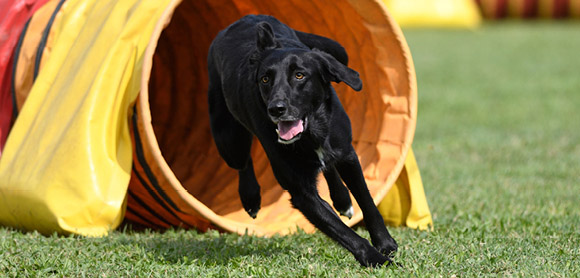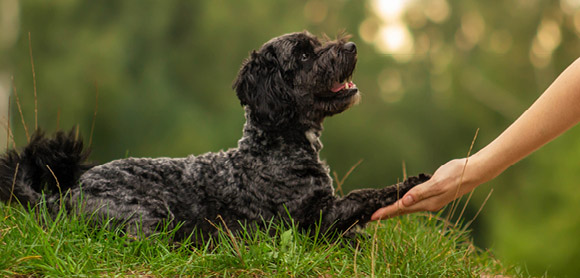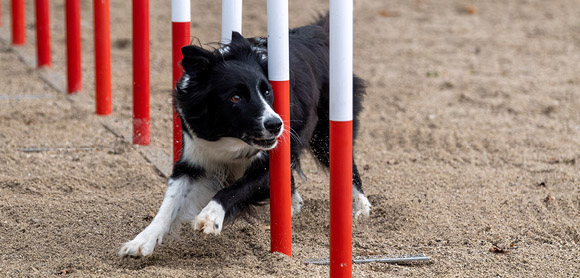Dog training is one of the most rewarding experiences of owning a dog, allowing you to set goals and establish a strong, trusting relationship with your pet. But how can you teach your dog tricks and commands?

Teaching your dog commands and tricks can be beneficial for all. It’s mentally stimulating for your dog and helps towards their development, as well as ensuring they are obedient – which also keeps them safe in most situations.
While training is best started when your dog is a puppy, older dogs are still capable of learning new tricks or having their training refreshed. Here’s how to get started.
Basic dog commands
It’s important for your pet to know basic dog commands such as sit, stay and come, as these will help you to keep them under control and avoid stressful situations – for instance, running off when not on the lead.
Remember that when you teach your dog a new command, you should reward them positively with either treats or affection. This will help your dog associate the correct action with the right command, and make training an all-round positive experience.
You should repeat and reinforce commands as often as possible to ensure your pup knows and remembers each different action.
How to teach a dog to sit
This basic dog command is a good place to start when it comes to obedience training.
Hold a treat to your dog’s nose and lift your hand over their head, towards the back of the neck. Hopefully, this will cause your dog to sit as they try to keep the treat in eyesight. Say ‘sit’ as your dog’s bottom touches the ground, and reward them by going back to them with the treat.
How to teach a dog to stay
The sit command also comes in handy when teaching your dog to stay.
Ask your dog to ‘sit’, then hold your palm up to them and say ‘stay’. Slowly step back and repeat the word ‘stay’. If your pup stays, reward them with a treat or a stroke. Then, try to increase the amount of time they stay before giving them a treat.

How to teach a dog to lie down
This is a useful command to use if you want to calm your dog. However, it’s recommended to teach your dog to ‘sit’ first, as this trick follows on from there.
Ask your dog to sit. Put a strong-smelling treat in front of them and allow them to smell it. Then move the treat along the floor and your dog should follow it, moving into a lying position. Once their belly is on the floor, say ‘lie down’ or ‘down’ and reward them with the treat.
How to teach a dog to come to you
This is the most useful and important command you can teach your dog, so you can always call them back when out.
Call your dog’s name enthusiastically – for instance, while crouching down and holding out your arms or clapping your thighs, saying ‘come’ as you do so. Reward them with a treat, cuddle or toy when they come to you.
Call your dog’s name followed by ‘come’ several times a day: at home, in the garden or on walks. If they learn that coming to you is a good thing, they will always return. You can find out more about what motivates your dog to learn here.
Always reward your dog for obeying, however long it takes. Stay patient and never tell them off for taking too long.
Fun tricks to teach your dog
Once you’ve mastered the basics, try learning some fun dog tricks with your pet, such as how to train a dog to give a paw, or how to roll over. Other dog commands can include:
- Giving a paw
- Spinning
- Taking a bow
- Jumping on command
- Fetching items on command
Find more information about training your dog here.

Top tips for training
While you might want to teach your pup a vast array of tricks and dog commands, here are some tips to keep in mind:
- One move at a time: try not to overwhelm your dog by teaching them multiple tricks or commands at any given time.
- Little and often: dogs can lose concentration easily, so get in the habit of doing a few short training sessions rather than one long one.
- Keep the noise down: keeping noise levels to a minimum when training helps to avoid unnecessary distractions.
- Be consistent: make sure everyone in the household is using the same words for commands to avoid confusion.
Most importantly, stay calm and patient. Dog training should ultimately be a fun experience for both you and your dog. Try not to become impatient and don’t lose your temper. Reward your dog’s good behaviour and encourage them to try again if learning is a little slow.
How to train a senior dog
Although older dogs may not be quite as alert as they used to be, your dog is always learning. So you can teach an old dog new tricks. You’ll need kindness and consistency, as positive reinforcement is essential. Bear in mind that an older dog may take longer to learn, and find it a little harder to adjust to new routines. Work gradually, with patience and repetition. Too much change, too quickly, can be stressful for older dogs, so use age-appropriate training techniques.
If your dog has behavioural issues, such as excessive barking or toilet problems, it’s often best to seek advice from your vet or a pet behaviourist. By taking out dog insurance with Petplan, you can gain access to pet behaviourists and experts on demand by heading to MyPetplan and utilising the expert chat feature.
Do you have any tips to share from training your dog? Share them with other owners on Petplan’s Facebook page.